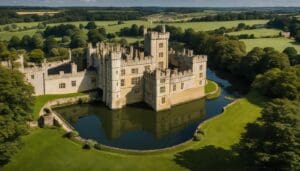Croagh Patrick – Ultimate climbing guide and the interesting history of the Reek
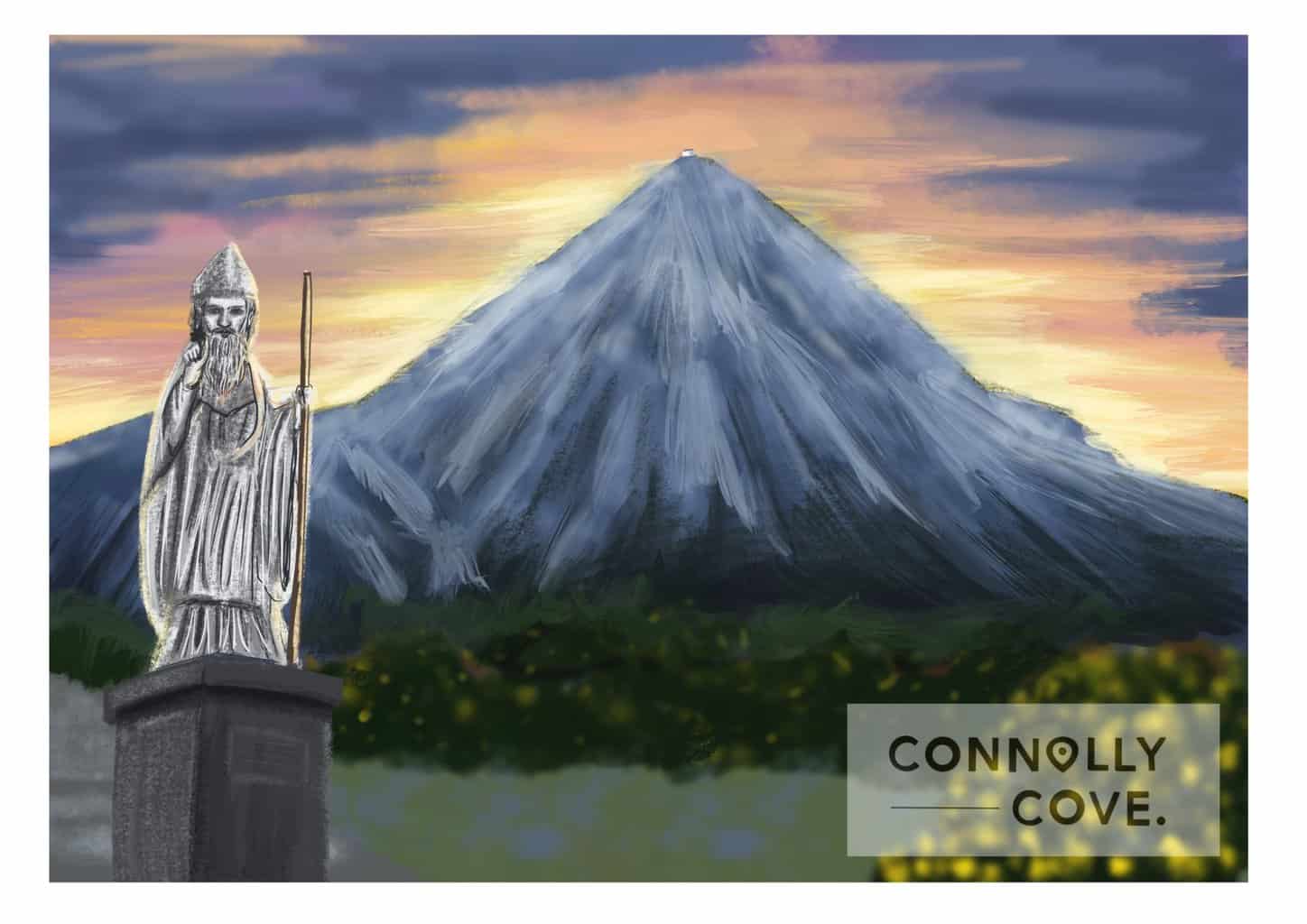
Updated On: April 20, 2024 by Ciaran Connolly
Found in Co. Mayo, Croagh Patrick is a quartzite mountain that reaches 764 metres in height. Nicknamed ‘the Reek’ by locals, the mountain is also an important place of pilgrimage. The pyramid shaped mountain over looks Clew Bay and the village of Musk. It is also only a 10 minute drive away from the town of Westport.
In this article you will find out everything you need to know about Croagh Patrick, including its history and practical advice for climbing the mountain.
The following sections are included below:
- Why is it called Croagh Patrick?
- Pre-Christian History of Croagh Patrick
- Mythology surrounding Croagh Patrick
- History of Croagh Patrick
- Reek Sunday
- Climbing Croagh Patrick – FAQ’s and General Advice
Why is it called Croagh Patrick
Croagh Patrick is the anglicisation of the Irish word Cruach Phádraig, which means Patrick’s stack. It is believed that Saint Patrick spent 40 days and 40 nights fasting on top of the mountain and in the fifth century a church was built at the mountains summit.
Croagh Patrick is pronounced ‘Crow Patrick’
The mountain is climbed by thousands of pilgrims on the last Sunday of July which is known as Reek Sunday.
Pre-Christian History of Croagh Patrick
The importance of the mountain predates history itself in Ireland. It was Christian monks who recorded most of the history of Ireland. It is worth nothing that some details were altered or removed to better suit Christian ideals. So for thousands of years before this, history and myth was passed down from generation to generation by word of mouth.
We have learned about Croagh Patrick from the recorded history as well as the surviving ancient sites.
Long before the arrival of Saint Patrick, the Reek was considered a holy mountain. Due to the many prehistoric monuments, it is believed that the mountain was a location of spiritual importance dating as far back as the Neolithic period (New Stone Age 3000BC-2000BC), but became more popular during the Bronze Age (2000BC-500BC).
Prehistoric monuments include the Boheh Stone, also known as ‘Saint Patrick’s Chair’, which is covered with ancient rock art or stone carvings. The stone is located just east of the mountain. It was discovered that in late-April and late-August, the sun appears to ‘roll’ down the slope of the Reek as it sets when standing at the Boheh stone. It would be foolish to think this is just a coincidence, especially when sites like New Grange highlight how skilled our ancestors were at constructing monuments which integrated elements of nature, including the sun.
These months are also significant as they highlight the beginning and end of the growing season. It is reasonable to believe that the first settlers in Ireland made pilgrimages to the mountain, as there is evidence to suggest the history of the holy mountain goes back even further, to the Mesolithic stone age (5800BC).
Dozens of Bronze Age huts were found along an enclosure surrounding the mountain top, along with more huts beside it.
The festival of Lughnasadh at Croagh Patrick
Before Saint Patrick made his pilgrimage, the mountain was also the site of the Lughnasadh Festival, celebrated on the first of August. Lughnasadh honoured the Celtic God Lugh of the Tuatha de Danann and celebrated a good harvest. Festivals took place across the country including on mountains such as the Reek. It was celebrated as a fire festival. This makes sense considering the function of the Boheh stone was related to the sun and that Lugh is considered the god of the sun.
One way of celebrating Lughnasadh was by making a pilgrimage to the top of the Reek on August first. Considering that Reek Sunday takes place on the last Sunday in July usually just a few days before the 1st of August, it is hard to refute the connection the two pilgrimages have.
When Christianity arrived in Ireland many Celtic or pagan holidays were replaced with Christian alternatives. This was likely because it was easier to adapt a holiday to celebrate Christian values than to remove it altogether when it was already so ingrained in society.
You can learn more about Lughnasadh and the three other Celtic festivals (one of which became a holiday you probably celebrate) by reading our article about Famous Irish Traditions!
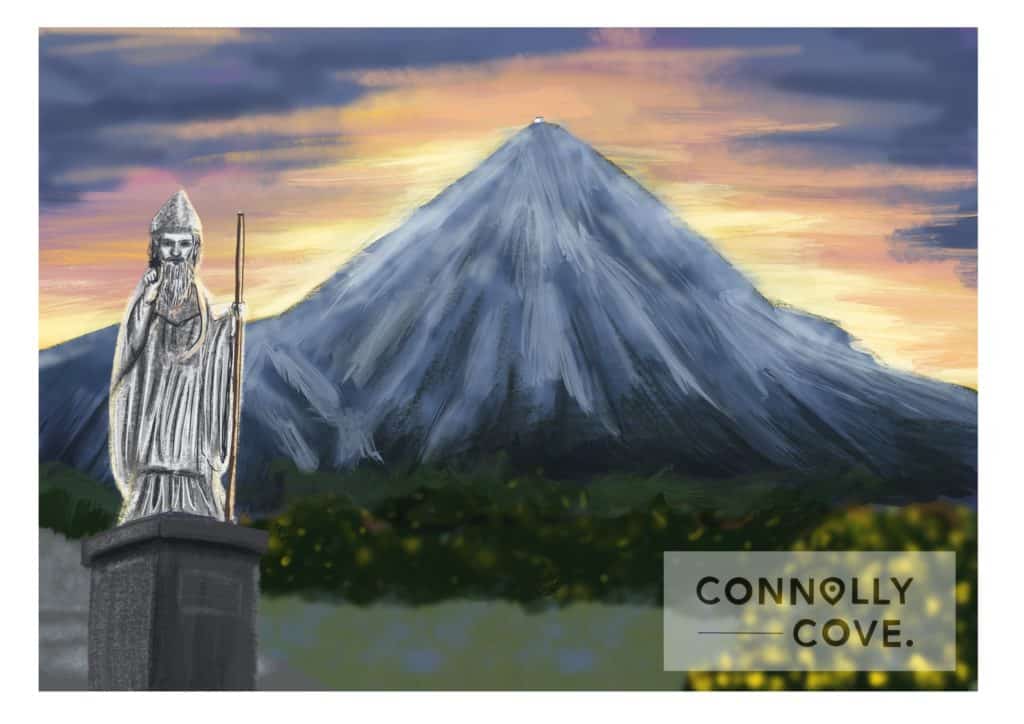
The Spring Equinox and Croagh Patrick:
Saint Patricks Day is celebrated within a few days of the Spring Equinox. The Spring Equinox marks the beginning of Spring and for pagans it was one for the most important times of the year as it signified new life and the end of Winter.
Considering Christian feast days have a habit of merging with pagan festivals in Ireland, it is more than possible that ‘Paddy’s Day’ is actually celebrated on the 17th of March because of the Spring Equinox, not because the saint died on this day, according to New Granges offical website.
It was more than a thousand years after the saint died, that the 17th of March was renamed Saint Patricks day. As we have mentioned, much of Ireland’s history was passed down by word of mouth, so it is more than possible that the connection between the Equinox was lost by the time of recording.
Considering the Equinox celebrates the beginning of the light half of the year and Lughnasadh (the festival of the sun god) was celebrated in this location in the past, this is a theory that we find fascinating! Even as a native to the West of Ireland, I had never heard of this connection before researching information for this article.
The Equinox line
Allegedly, Saint Patrick arrived at Inber Colpa in Ireland and the first priest he ordained lit a Paschal fire at Slane to celebrate the beginning of Easter. This was around the time of the Spring Equinox, when the High Kings of Ireland lit fires at the Hill of Tara. As we cover in more detail below, lighting a fire before the king at this festival was severely punishable, but the druids soon found that Patrick’s fire was inextinguishable and so the conversion to Christianity in Ireland had begun.
The astronomical relevance is that there is a ‘straight line’ that links Croagh Patrick to Slane and then to Millmount mound and the Boyne Estuary (where the Hill of Tara is located) passing through many historic sites along the way.
This straight line can be seen when connecting the locations on a map. It probably has something to do with being able to see the sun setting on one location when looking from another. New Grange’s light function at the Winter solstice highlights how skilled the Celts were at astronomy. When standing at Millmount mound in Drogheda, you can see the sun set directly over Slane. Although you can’t see it from Slane, the sun is setting directly over Cruach Phádraig too.
Admittedly we don’t know as much about astronomy as our ancestors, but you can read more about the equinox line on mythical Ireland’s website to learn more about the theory.
The Mayo News have also wrote an article about the alignment, suggesting that St. Patricks journey from East to West was very intentional, and many of the historic sites found along the line were created there for the same reason. What do you think?
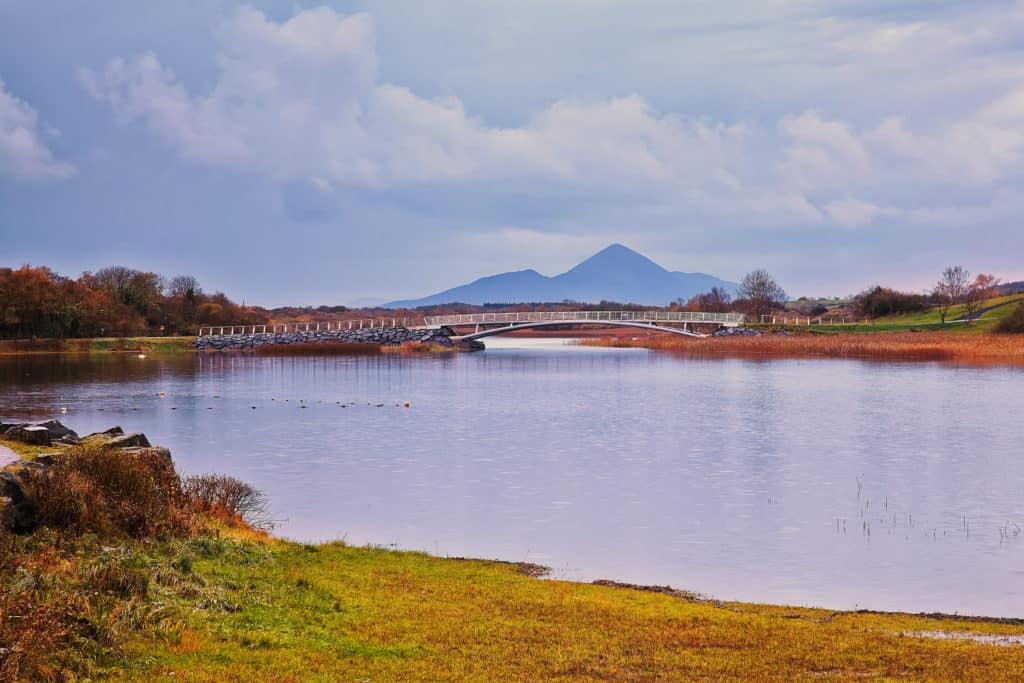
Mythology surrounding Croagh Patrick
Fact and myth have become intertwined when exploring the life of St. Patrick. The legend of Saint Patrick states that Patrick spent 40 days of Lent (A period of fasting leading up to Easter) on Croagh Patrick.
According to myth, Saint Patrick was harassed by demons disguised as blackbirds. He continued to pray and rang a bell to proclaim his faith. As a result of his perseverance, an angel told him that his mission to bring Christianity to Ireland would be successful and that people would remain faithful until Judgement Day.
In folklore the bell was originally white but after Patrick banished demons with it, it turned black.
Other myths involving Saint Patrick
St. Patrick has become an important part of Irish legend. From teaching the Holy Trinity by using a three leafed shamrock to allegedly performing miracles more magical than druids themselves, he is said to have been responsible for spreading Christian faith around Ireland.
Banishing the snakes from Ireland
Other myths involving Saint Patrick include banishing all of the snakes from Ireland. It is unlikely that snakes ever actually existed in Ireland as there is no archaeological evidence to suggest so, but this story acts as a powerful metaphor.
Snakes were sacred to druids, the ancient priests, judges and scholars of Ireland. So when Patrick banished the snakes, he was essentially banishing paganism from Ireland.
Creating the first Celtic Cross
St. Patrick is credited with creating the first Celtic cross. He came across a group of Celtic people at a standing stone. A circle was carved into the stone, representing the pagan sun and moon Gods.
St. Patrick is said to have drawn a cross through the circle. The symbolic importance of this is that he did not destroy pagan rituals, festivals or ideas, instead he showed that they could be adapted into the Christian faith.
Magic Fire
The Celtic festival of Bealtaine celebrated the beginning of Summer. Traditionally, the High King of Tara would light a fire at the top of the Hill of Tara. This fire would then be used to light every other fire in the festival. It was a severe crime to light a fire before the King during the festival.
St. Patrick supposedly lit the first fire of the festival. According to legend, this fire was impossible to extinguish. His act of rebellion was seen as magic greater than the king or druids had ever grasped and so they allowed St. Patrick to continue his mission converting Ireland to Christianity.
History of Croagh Patrick
It is believed that St. Patrick climbed the reek around 441AD. At that time it was known as Mons Egli, Croachan Aigli, or Cruachan Aigli.
It was not until 1350, hundreds of years after the death of the Saint (March 17th 465 AD), that the mountain was renamed ‘Cruaich Patrick’. In the sixteenth century, this was anglicised to Croagh Patrick.
National Famine Monument
Did you know that the National Famine Monument depicting ‘coffin ships’ is found close to Murrisk and Croagh Patrick. Created by Dublin artist John Behan, the memorial commemorates all of those who died during the Great Famine (1845-1849).
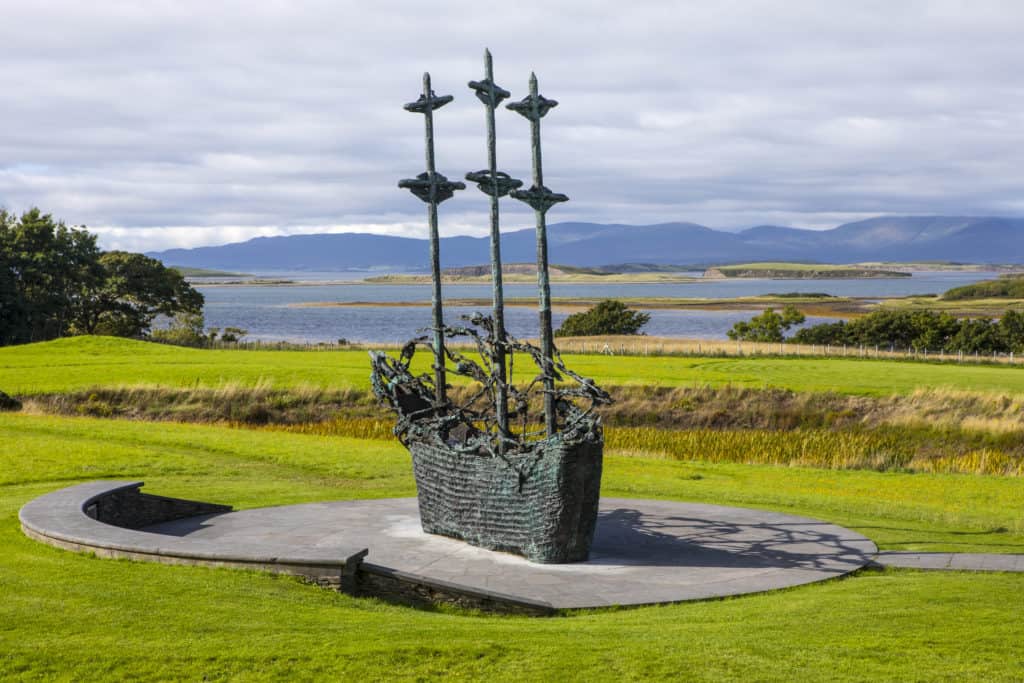
1900’s: The Chapel was built
In 1905 a small chapel was built on top of the summit of the mountain. 100 years later the centenary of the chapel was celebrated. It was announced that the church would open every day during the summer months (June-August) rather than just holy days.
The Church was built by 12 local men using stone and cement brought up the mountain by donkeys. It is thought that around 10,000 people attended the dedication ceremony.
1970’s: Night Pilgrimage
Up until 1973, pilgrimages would take place at night, after sunset. Since 1973 it has been completed during the day which is a much safer way of climbing the mountain.
1980’s: Gold Discovered at Croagh Patrick
During the 1980’s a seam of gold was discovered at Cruach Phádraig It was estimated that 300,000 troy oz of gold worth over €360 million potentially lay in the area. Mayo county council ultimately decided against mining to preserve the mountain.
During the Bronze Age, gold was plentiful in Ireland. Infact, it was believed that the areas surrounding Croagh Patrick, including Clew bay were considered the ‘Gold Coast of Ireland’. This beautiful and precious metal would have surely contributed to the idea that the mountain was a very special place.
Reek Sunday
Reek Sunday is the last Sunday in July and the day upon which many pilgrims climb the mountain. The seven days leading up to the last Sunday are also known as Reek Week.
Reek Sunday is called ‘Domhnach na Cruaiche’ in Irish and it may also be known as Garlands Sunday.
Anywhere from 15,000 to 30,000 people may climb mass on Reek Sunday. This large difference greatly depends on the weather conditions.
Why is Croagh Patrick known as the Reek?
Croagh Patrick is commonly known by locals as the Reek. The word ‘reek’ is derived from Irish and means rick or stack.
Climbing Croagh Patrick – FAQ’s and General Advice
Where is Croagh Patrick located?
The GPS Co-ordinates of Croagh Patrick are 53.7599° N, 9.6598° W.
Croagh Patrick is located near the town of Westport, one of our favourite towns to visit in the West of Ireland.
How long does it take to climb Croagh Patrick?
It roughly takes three hours and 30 minutes to complete an up and down climb of Croagh Patrick.
What should I wear climbing Croagh Patrick?
The weather in Ireland is nothing if not unpredictable, so it is important to come prepared when climbing Croagh Patrick!
You should wear:
- Warm layers of clothing (weather can change from cold to hot quite frequently, so layers are ideal)
- A light waterproof jacket (it can rain at anytime in Ireland)
- Good broken-in walking shoes, preferably boots.
- Sun cream (even on overcast days, as sun and wind burn can be deceiving)
What should I bring to Croagh Patrick?
It’s important to find a balance between bringing everything you may need and not having to carry a heaving bag.
- Climbing sticks – an essential tool for steep parts of the mountain
- Bottles of water and a small snack
- Your phone. Have an estimated time of arrival back arranged with someone. Plus it doubles up as a camera to capture the stunning views!
- Sunglasses, gloves or hats depending on the weather
- Travel insurance (better safe than sorry!)
Do people climb Croagh Patrick Barefoot?
As Croagh Patrick was originally a pilgrimage, people climbed the mountain barefoot as a sign of penance. This added another dimension of challenge to the climb as the sharp rocks could easily cut the pilgrims.
We’d strongly recommend wearing the most protective footwear possible. It is not considered disrespectful to wear shoes when climbing the mountain and it will help you to avoid any painful injuries. Most pilgrims do wear shoes when climbing the mountain nowadays.
What facilities are offered near Croagh Patrick?
There are toilets located near the entrance. Showers are available for minimal charge. There is also a craft/gift shop, a coffeeshop/restaurant and ‘Campbells at the Reek’ Pub which also offers food and drink options.
What Route should I take when climbing Croagh Patrick?
There are a number of routes up the mountain. The most popular route is the Pilgrim route, which is the easiest to find as it starts at the car park. Signs point to the trail from the carpark.
The trail starts off simple enough as a chiselled path leads walkers to a white statue of Saint Patrick and a gate which opens up into the mountain. There are three parts of the trail, first of is the simple beginning which connects to the shoulder of the mountain and second stage of the route.
This part of the trail can get steep at times. The final part of the journey is an impressively steep climb to the summit. Its important to remind people that it is okay to stop halfway and return back to solid ground if you are feeling uncomfortable or tired; you will still see many beautiful sights on your way up.
It is often said that the journey down is more difficult due to the steep slope of the mountain. Take your time and bring walking sticks if possible.
Final Thoughts
You may choose to stay nearby after the climb. There are so many charming towns and welcoming villages that are very tourist friendly in the surrounding area.
We hope that you have enjoyed our article about Croagh Patrick. A fascinating history, combined with a challenging climb and spectacular views has turned this Mayo location into one of Ireland’s travel gems! Have you ever climbed the Reek? We would love to hear your stories in the comments below!


